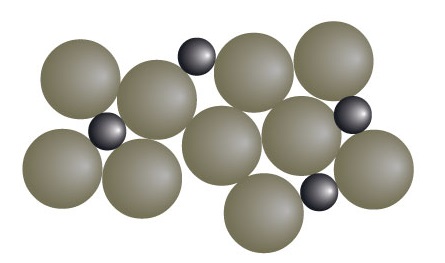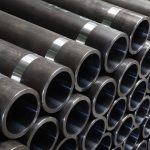Isothermal Transformation Diagrams
We use as an example the cooling of an eutectoid alloy (0.8 % C) from the austenite (γ- phase) to pearlite, that contains ferrite (α) plus cementite (Fe3C or iron carbide). When cooling proceeds below the eutectoid temperature (727 oC) nucleation of pearlite starts. The S-shaped curves (fraction of pearlite vs. log. time, fig. 10.3) are displaced to longer times at higher temperatures showing that the transformation is dominated by nucleation (the nucleation period is longer at higher temperatures) and not by diffusion (which occurs faster at higher temperatures).
The family of S-shaped curves at different temperatures can be used to construct the TTT (Time- Temperature-Transformation) diagrams For these diagrams to apply, one needs to cool the material quickly to a given temperature To before the transformation occurs, and keep it at that temperature over time. The horizontal line that indicates constant temperature To intercepts the TTT curves on the left (beginning of the transformation) and the right (end of the transformation); thus one can read from the diagrams when the transformation occurs. The formation of pearlite indicates that the transformation occurs sooner at low temperatures, which is an indication that it is controlled by the rate of nucleation. At low temperatures, nucleation occurs fast and grain growth is reduced (since it occurs by diffusion, which is hindered at low temperatures). This reduced grain growth leads to fine-grained microstructure (fine pearlite). At higher temperatures, diffusion allows for larger grain growth, thus leading to coarse pearlite.
At lower temperatures nucleation starts to become slower, and a new phase is formed, bainite. Since diffusion is low at low temperatures, this phase has a very fine (microscopic) microstructure.
Spheroidite is a coarse phase that forms at temperatures close to the eutectoid temperature. The relatively high temperatures caused a slow nucleation but enhances the growth of the nuclei leading to large grains.
A very important structure is martensite, which forms when cooling austenite very fast (quenching) to below a maximum temperature that is required for the transformation. It forms nearly instantaneously when the required low temperature is reached; since no thermal activation is needed, this is called an athermal transformation. Martensite is a different phase, a body- centered tetragonal (BCT) structure with interstitial C atoms. Martensite is metastable and decomposes into ferrite and pearlite but this is extremely slow (and not noticeable) at room temperature.
In the examples, we used an eutectoid composition. For hypo- and hypereutectoid alloys, the analysis is the same, but the proeutectoid phase that forms before cooling through the eutectoid temperature is also part of the final microstructure.


